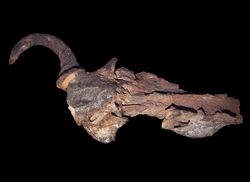Biology:Megalotragus
| Megalotragus | |
|---|---|

| |
| Megalotragus kattwinkeli skull | |
| Scientific classification | |
| Domain: | Eukaryota |
| Kingdom: | Animalia |
| Phylum: | Chordata |
| Class: | Mammalia |
| Order: | Artiodactyla |
| Family: | Bovidae |
| Subfamily: | Antilopinae |
| Tribe: | Alcelaphini |
| Genus: | †Megalotragus van Hoepen, 1932 |
| Type species | |
| †Megalotragus kattwinkeli | |
| Species | |
| |
Megalotragus (from Greek mega (μέλα) 'great' and tragos (τράγος) 'goat') was a genus of very large extinct African alcelaphines that occurred from the Pliocene to early Holocene.[1][2] Its skull resembled that of modern hartebeests, but it differed in having a larger body size and wildebeest-like proportions.[3] Megalotragus includes some of the largest bovid species in the subfamily Alcelaphinae, reaching a shoulder height of 1.4 m (4.6 ft). The genus consists of three species of which Megalotragus priscus survived until the early Holocene 7.500 C14yBP.[2]
Description
With a distance between the tips of its horns of around 1.2 m (3 ft 11 in),[4] Megalotragus is probably the largest alcelaphine bovid ever recorded,[5] much bigger than the extant wildebeest.[6] The skull of Megalotragus is similar to that of the hartebeest: characterized by extreme elongation, and the fusion and posterior placement of the horn pedicels. However, it's postcrania and proportions are largely reminiscent of wildebeest: for instance, axes from Megalotragus are robust and compact, suggesting it had a robust, muscular neck that was likely held horizontally, much like black wildebeest.[7]
The nasal region of Megalotragus (with the exception of Megalotragus priscus) is inflated and forms a domed structure.[5] This is similar to the related Rusingoryx (once included in Megalotragus) but not as extreme. The type species M. kattwinkeli has relatively short, curved horns. M. isaaci possessed longer horns, while M. priscus possessed the longest horns of all three species.[8]
References
- ↑ Turvey, S.T. (2009). Holocene mammal extinctions. In: Turvey, S.T. (editor) (2009). Holocene extinctions. Oxford University Press, Oxford, UK.
- ↑ 2.0 2.1 Thackeray, John Francis. (2015). Faunal Remains from Holocene Deposits, Excavation 1, Wonderwerk Cave, South Africa. African Archaeological Review.
- ↑ Brink, J.S. (2005). The Evolution of the Black Wildebeest, Connochaetes gnou, and Modern Large Mammal Faunas in Central Southern Africa (PDF) (PhD). University of Stellenbosch.
- ↑ Report of the South African Association for the Advancement of Science. Volume 96. South African Association for the Advancement of Science. 2000. pp. 163. https://books.google.com/books?id=R80PAQAAMAAJ. Retrieved 17 September 2022.
- ↑ 5.0 5.1 Terry Harrison (January 27, 2011). Paleontology and Geology of Laetoli: Human Evolution in Context. Volume 2: Fossil Hominins and the Associated Fauna. Springer Netherlands. pp. 404. ISBN 9789048199624. https://books.google.com/books?id=s9Lj-EJEbgsC. Retrieved 17 September 2022.
- ↑ Discovery. Magazine of the Peabody Museum of Natural History, Yale University. Volumes 13-16. Peabody Museum of Natural History. 1978. pp. 9. https://books.google.com/books?id=U-dJAAAAYAAJ. Retrieved 17 September 2022.
- ↑ Brink, J.S. (2005). The Evolution of the Black Wildebeest, Connochaetes gnou, and Modern Large Mammal Faunas in Central Southern Africa (PDF) (PhD). University of Stellenbosch.
- ↑ Werdelin, Lars; Sanders, William Joseph (2010). Cenozoic Mammals of Africa. University of California Press. p. 784. ISBN 9780520257214.
Wikidata ☰ Q3012079 entry
 |

